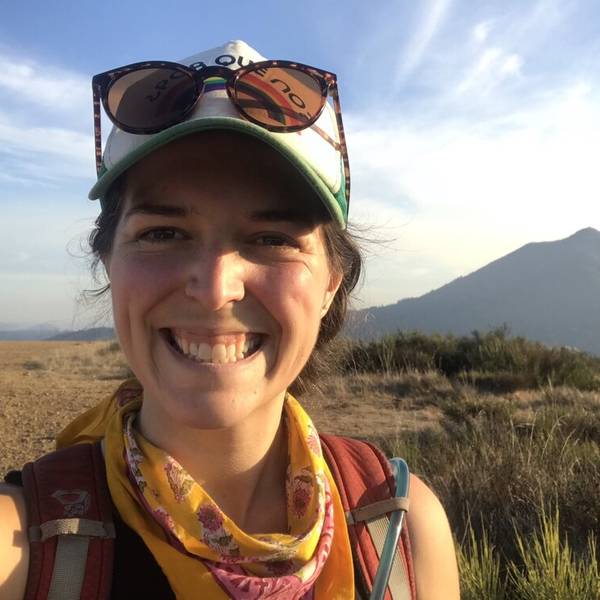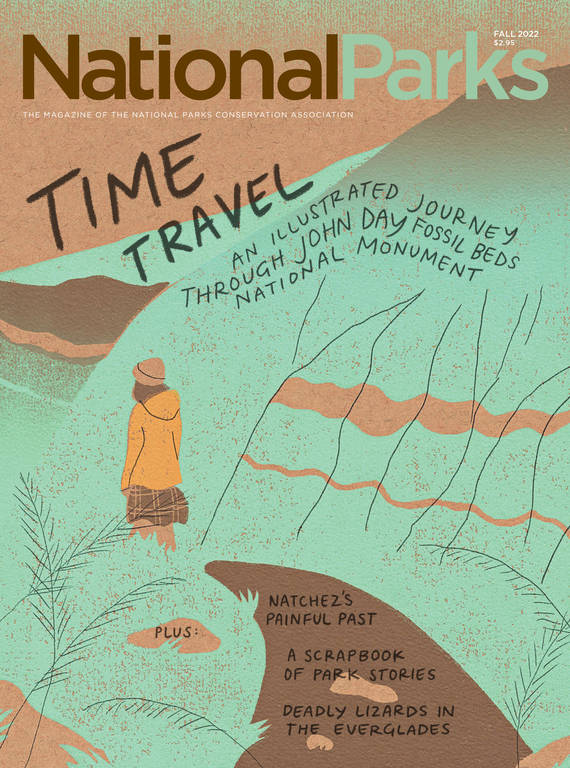Fall 2022
To Collect or Not to Collect
As higher visitation and climate change increasingly threaten artifacts, can the Park Service afford to leave them in place?
The olla lay in a hollow under a boulder on the right bank of the Colorado River for a very long time. Sheltered from monsoon rains, shaded from the desert sun and perched above the floods that scoured the Grand Canyon every spring until dams were built upstream, the ceramic jar sat as a silent reminder of the Ancestral Puebloan people’s millennia-long relationship to this place.
National Park Service archaeologists first documented the pot in its niche in 1990. Though park staff sought to keep its location secret, word of the remarkable object started to spread. In 2008, rangers noted a faint trail up to the olla’s perch from the riverbank. “The pot remains intact and in place, though it has clearly been removed and handled, perhaps multiple times,” read a monitoring report. In early 2012, staff noted that “the site is regularly visited with a well-defined social trail.” In May of that year, rangers returned to find the nook empty and the pot sitting on the ground a short distance away. “It sure seemed like someone was getting ready to steal it, but then got cold feet,” said Ellen Brennan, an archaeologist who’s spent half of her long career at Grand Canyon National Park and recently wrote a paper about the olla.
Brennan and her colleagues faced a tough choice: Should they pluck this invaluable object from its longtime home, severing its connection to this particular bend in the river and carrying it off to sit in a dark room miles away up on the canyon rim? Or should they leave it in place and risk coming back to find it shattered, or worse, gone?
The case of the wandering olla reflects both the promise and the peril of caring for America’s heritage in the 21st century. In part to honor the wishes of Indigenous communities with ancestral ties to national parks, archaeologists now strive to leave artifacts where they’re found. This is a significant change from the era of indiscriminately collecting Indigenous cultural objects. But with growing park visitation and the widespread use of social media and mapping apps, visitors are ever more likely to stumble upon or seek out objects that have long persisted by dint of their relative obscurity. Meanwhile, the effects of climate change are exposing and damaging artifacts that were once safely buried. All of that means that leaving irreplaceable objects in their original locations also raises the risk of theft or destruction and that Park Service archaeologists are increasingly facing difficult decisions about the cultural resources in their care.
“I’m sure you’ve heard all about the paradox of the parks, right?” asked Josh Torres, the Park Service’s acting chief archaeologist. “We desperately want people to come and enjoy the amazing resources that we’re entrusted to preserve and protect for the American people. But there are times when doing so is almost antithetical to conservation and protection.” Conflicts between the agency’s preservation mandate and its public access goal are nothing new, but it’s up to each new generation of park stewards to renegotiate those competing priorities as attitudes evolve and new threats and challenges arise.
Well into the 20th century, archaeologists in national parks tended to collect whatever artifacts they came across, often without regard for either scientific rigor or the rights of the people whose ancestors created these objects. A Finnish museum, for example, currently houses about 600 Ancestral Puebloan artifacts that an archaeologist removed in the 1890s from what would become Mesa Verde National Park. (In 2020, the museum repatriated the remains of 20 people and 28 funerary objects that had been part of its collection to the Hopi Tribe, the Pueblo of Acoma, the Pueblo of Zia and the Pueblo of Zuni.) Yellowstone National Park’s museum holds over 35,000 archaeological objects collected within the park in the past 150 years. Brennan said the museum at Grand Canyon holds boxes of “random soils, pottery and wood” that archaeologists collected in the 1960s and ’70s but failed to process.

Digging in Native Soil
At Bighorn Canyon in Montana and Wyoming, an innovative archaeological field school partners with descendant communities.
See more ›“I liken it to looters or pothunters, who knowingly are stealing archaeological materials that serve no greater purpose than to grace their mantels,” Brennan said. “It doesn’t do anyone any good to collect artifacts without identifying information so they can be studied further into the future and tied back to furthering an understanding of human use and behavior.”
For many Indigenous communities, when archaeological sites are disturbed — whether by archaeologists, bulldozers or looters — much more than scientific data is lost. “The Zunis have a very personal, psychological, emotional connection to these ancestral places, which non-Zunis call archaeological sites,” said Kurt Dongoske. He’s the Tribal historic preservation officer for the Pueblo of Zuni, one of the 11 federally recognized Tribes with ancestral ties to Grand Canyon. “From a Zuni perspective, the ancestors that are residing in their eternal homes in these sites are still very much a live presence in spiritual form.” The removal of artifacts for archaeological research has severed vital connections to their ancestors, Dongoske said.
Preserving and restoring access to sacred sites and artifacts has been a priority for Indigenous activists and elders who’ve fought for Tribal sovereignty and self-determination since the American Indian Movement of the 1960s and ’70s. As a result, laws such as 1979’s Archaeological Resources Protection Act and the Native American Graves Protection and Repatriation Act of 1990 require federal agencies to formally consult Tribal governments and other descendant groups before excavating a site.
As archaeologists established working relationships with Tribal leaders, they began to realize that many of the answers they were seeking had been there all along. This shift in perspective made it harder for archaeologists in national parks to justify collecting objects in the name of research. “Certain descendant groups say, ‘There’s literally no question you could ask about that artifact that I couldn’t just tell you the answer to, so just leave it alone,’” said Elizabeth Hora, an archaeologist at the Utah State Historic Preservation Office, which consults with the Park Service on archaeological research in the state’s national park sites.
ARCHAEOLOGY RULES
“Going across the landscape and collecting materials is a thing of the past” for park archaeologists, Brennan said. Instead of relocating objects to controlled storage, park staff are now figuring out how to preserve artifacts where they’re found, but that’s not always possible.
“There are lots of instances where we do collect material if it looks like those resources will be lost or stolen,” said Torres. “We have an obligation to mitigate those adverse effects to those resources however we can.” These days, Park Service policy dictates that whenever park managers need to make a call about artifacts or sites that are at risk, they discuss options with the descendant communities of the people who created them. “In some instances, the management actions necessary to preserve or protect a particular site from destruction or a federal project may be counter to wishes of the Tribes,” Torres acknowledged. “But that’s the whole purpose of the consultation process: to try and work out amenable solutions.”
And as more material traces of the continent’s human past disappear under rising seas, wash away in freak storms, burn up in raging wildfires and melt out of waning ice patches, these sorts of decisions will only become more common. After unusually heavy rains in 2013, rangers at Arizona’s Wupatki National Monument noticed that a partially exposed structure built out of sandstone slabs on a hillside had started to erode. They spotted three clay vessels, exposed to the elements and teetering in a newly formed gully. Park staff couldn’t figure how to stabilize the slope, so in concert with Tribes associated with the park and Arizona’s State Historic Preservation Office, they decided to excavate the whole structure. All told, they found seven intact pots dating to the 12th century.
It’s rare to find one intact pot in the field, let alone seven, said Gwenn Gallenstein, museum curator for the three national monuments near Flagstaff including Wupatki. “It caused quite a bit of excitement in the community.” Friends of Flagstaff National Monuments drummed up some funding for a new visitor center display, which would feature the vessels and other objects as part of a story about how climate change is accelerating threats to the park’s archaeological resources.
But in consultation for the exhibit with a group of Hopi elders, Gallenstein learned that the site had most likely been a shrine that could have been created to contain something harmful, like an illness. The elders explained that “its contents shouldn’t be utilized for any purpose, handled by any person or kept in storage for research,” Gallenstein recalled. It would have been better, the elders told her, if park staff had left the pots to erode away, but federal regulations mandate that archaeological objects recovered from federal land be preserved, meaning Gallenstein couldn’t just return the pots to the gully where they’d soon be smashed to bits. So the Hopi elders and the park’s superintendent struck a compromise. A few weeks later, park archaeologists dug a pit in a stable area near the site and reburied the shrine’s contents.
Back at Grand Canyon, Brennan and her colleagues also sought a solution somewhere between accessioning the olla into the park’s permanent collection and leaving it in its increasingly perilous home. Tribal representatives had told Brennan that they wanted the pot to stay in the canyon — unless it seemed the object was in danger. “Once someone took it out of the site context, we knew at that point we had to remove it,” she said.

National Parks
You can read this and other stories about history, nature, culture, art, conservation, travel, science and more in National Parks magazine. Your tax-deductible membership donation of $25 or more entitles…
See more ›So with a go-ahead from the Tribes, park staff orchestrated a rescue mission involving cotton gloves, bubble wrap, a sturdy metal box and a 166-mile river journey through dozens of major rapids. (“Intact vessels are so fragile and so rare. You don’t want to be the one that breaks it,” Brennan said. “So yeah, it’s nerve-wracking.”) The olla arrived at the park’s museum undamaged. In the past, the park’s archaeologists might have proceeded to zap the pot with an X-ray machine, swab its surface for traces of ancient pollen or put it on display in the visitor center, but Brennan and her colleagues made a different plan. “It wasn’t just that I want to protect the object from theft,” she said. “I was also thinking about how the Tribes think about these sites as still-living entities.” So she hopes that someday the pot can be returned to its riverside home. “In the meantime, we haven’t done anything with it,” she said. “It’s just been sitting, waiting quietly for us to put it back.”
About the author
-
 Julia Busiek Author
Julia Busiek AuthorJulia Busiek is a writer living in Oakland. She's worked in national parks in Washington, Hawaii, Colorado and California.



